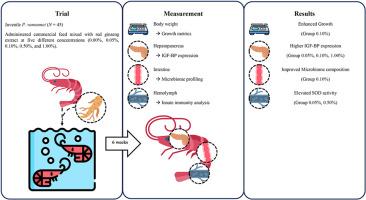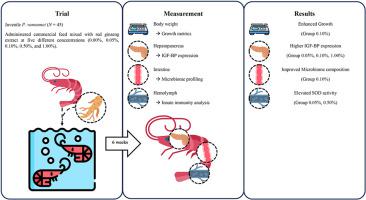The effects of Panax ginseng on growth enhancement, innate immunity, and microbiome profiling in Penaeus vannamei
IF 6.8
2区 医学
Q1 CHEMISTRY, MEDICINAL
引用次数: 0
Abstract
Background
In aquaculture, feed additives are widely explored. Among them, Panax ginseng Meyer, a natural herbal remedy, has demonstrated its efficacy in many aquaculture species. However, research regarding Penaeus vannamei shrimp, one of the most significant species in aquaculture, remains limited.
Methods
This study investigates the benefits of P. ginseng for P. vannamei, specifically its effects on growth, innate immunity, and shrimp microbiome. Juvenile P. vannamei were fed commercial feed mixed with red ginseng extract at 5 concentrations (0.00 %, 0.05 %, 0.10 %, 0.50 %, and 1.00 %) for 6 weeks. Body weight was measured on days 21 and 42. On day 42, three shrimp per group were selected for further analysis.
Results
In the growth study, Group 0.10 % displayed significantly improved FBW, WG, SGR, and FCR compared to those in Group 0.00 % on day 42. The qPCR assay showed significantly higher IGF-BP gene expression in Groups 0.05 %, 0.10 %, and 1.00 % compared to Group 0.00 %. In the innate immunity analysis, SOD activity was significantly higher in Groups 0.05 % and 0.50 % compared to that in Group 0.00 %. In the bacterial community analysis, Group 0.10 % exhibited higher Flavobacteriaceae and lower Vibrionaceae at the family level compared to Group 0.00 %. At the genus level, Group 0.10 % showed increased unspecified Flavobacteriaceae and decreased Vibrio compared to Group 0.00 %.
Conclusion
Adding P. ginseng to the feed enhanced growth, immune response, and microbiome composition in P. vannamei. Further research on refining dosage levels and utilizing red ginseng residues could boost commercial productivity and economic benefits in aquaculture practices.


三七对万年青生长、先天性免疫和微生物组谱分析的影响
在水产养殖中,饲料添加剂被广泛使用。其中,梅耶作为一种天然草药,已在许多水产养殖物种中证明了其功效。然而,对虾作为水产养殖中最重要的物种之一的研究仍然有限。本研究调查了红霉素的益处,特别是其对生长、先天免疫和对虾微生物组的影响。用 5 种浓度(0.00 %、0.05 %、0.10 %、0.50 % 和 1.00 %)的红参提取物混合商业饲料喂养幼虾 6 周。第 21 天和第 42 天测量体重。第 42 天,每组挑选三只虾进行进一步分析。在生长研究中,与 0.00 % 组相比,0.10 % 组在第 42 天的 FBW、WG、SGR 和 FCR 都有明显改善。qPCR 检测显示,与 0.00 % 组相比,0.05 %、0.10 % 和 1.00 % 组的 IGF-BP 基因表达量明显更高。在先天性免疫分析中,0.05 % 组和 0.50 % 组的 SOD 活性明显高于 0.00 % 组。在细菌群落分析中,与 0.00 % 组相比,0.10 % 组的黄杆菌科细菌较多,弧菌科细菌较少。在属一级,与 0.00 % 组相比,0.10 % 组显示出更多的未指定黄杆菌科细菌,而弧菌则有所减少。添加到饲料中可提高......的生长、免疫反应和微生物组组成。进一步研究细化剂量水平和利用红参残留物可提高水产养殖实践中的商业生产力和经济效益。
本文章由计算机程序翻译,如有差异,请以英文原文为准。
求助全文
约1分钟内获得全文
求助全文
来源期刊

Journal of Ginseng Research
CHEMISTRY, MEDICINAL-INTEGRATIVE & COMPLEMENTARY MEDICINE
CiteScore
11.40
自引率
9.50%
发文量
111
审稿时长
6-12 weeks
期刊介绍:
Journal of Ginseng Research (JGR) is an official, open access journal of the Korean Society of Ginseng and is the only international journal publishing scholarly reports on ginseng research in the world. The journal is a bimonthly peer-reviewed publication featuring high-quality studies related to basic, pre-clinical, and clinical researches on ginseng to reflect recent progresses in ginseng research.
JGR publishes papers, either experimental or theoretical, that advance our understanding of ginseng science, including plant sciences, biology, chemistry, pharmacology, toxicology, pharmacokinetics, veterinary medicine, biochemistry, manufacture, and clinical study of ginseng since 1976. It also includes the new paradigm of integrative research, covering alternative medicinal approaches. Article types considered for publication include review articles, original research articles, and brief reports.
JGR helps researchers to understand mechanisms for traditional efficacy of ginseng and to put their clinical evidence together. It provides balanced information on basic science and clinical applications to researchers, manufacturers, practitioners, teachers, scholars, and medical doctors.
 求助内容:
求助内容: 应助结果提醒方式:
应助结果提醒方式:


